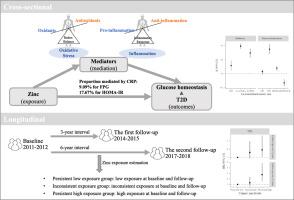Environmental Pollution ( IF 7.6 ) Pub Date : 2022-10-01 , DOI: 10.1016/j.envpol.2022.120331 Zi Ye 1 , Ruyi Liang 1 , Bin Wang 1 , Linling Yu 1 , Wei Liu 1 , Xing Wang 1 , Lili Xiao 1 , Jixuan Ma 1 , Min Zhou 1 , Weihong Chen 1

|
The link between zinc exposure and glucose metabolism or the development of type 2 diabetes (T2D) is controversial, and underlying mechanisms are unclear. This study aimed to explore the associations of zinc exposure with glucose-insulin homeostasis traits and the long-term effects of zinc on the development of T2D, and further to estimate the potential roles of inflammation and oxidative damage in such relationships. We investigated 3890 urban adults from the Wuhan-Zhuhai cohort, and followed up every three years. Mixed linear model was applied to estimate dose-response associations between urinary zinc and glycemia traits [fasting plasma insulin (FPI), fasting plasma glucose (FPG), insulin resistance (homeostasis model assessment of insulin resistance, HOMA-IR), and β-cell dysfunction (homeostasis model assessment of β-cell function, HOMA-B)], as well as zinc and biomarkers for systemic inflammation (C-reactive protein) and oxidative damage (8-isoprostane and 8-hydroxy-2′-deoxyguanosine). Logistic regression model and Cox regression model were conducted to evaluate the relationships between urinary zinc and prevalence and incidence of T2D, respectively. We further performed mediation analysis to assess the roles of inflammation and oxidative damage biomarkers in above associations. At baseline, we observed significant dose-response relationships of elevated urinary zinc with increased FPI, FPG, HOMA-IR, and T2D prevalence and decreased HOMA-B, and such associations could be strengthened by increased C-reactive protein, 8-isoprostane, and 8-hydroxy-2′-deoxyguanosine. Elevated C-reactive protein significantly mediated 9.09% and 17.67% of the zinc-related FPG and HOMA-IR increments, respectively. In longitudinal analysis, a significantly positive association between urinary zinc and T2D incidence was observed among subjects with persistent high urinary zinc levels when compared with those with persistent low zinc levels. Our results suggested that high levels of zinc exposure adversely affected on glucose-insulin homeostasis and further contributed to increased risk of T2D cross-sectionally and longitudinally. Moreover, inflammatory response might play an important role in zinc-related glucose metabolic disorder.











































 京公网安备 11010802027423号
京公网安备 11010802027423号